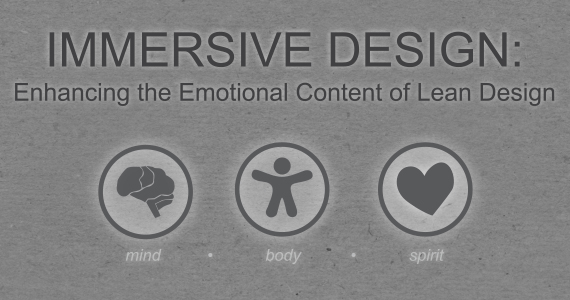

The text below is a condensed version of Kent Doss’s White Paper, “IMMERSIVE DESIGN: Enhancing the Emotional Content of Lean Design.”
The operational (and associated long-term fiscal) benefits of applying Lean Design principals to healthcare planning are well documented. The process of mapping current state realities, ideal future state conditions and defining the steps needed to make a successful transition between the two have become an integral part of maximizing returns on investment for institutional facilities.
The strategies and tools employed in Lean Design are finely tuned to increase efficiencies in the conceptualization and execution of procedural operations. As healthcare designers, we have come to rely on direct observation (i.e. “shadowing”) of caregivers, support staff and patients as they go about their daily routines or specific processes so that we can design spaces that account for their needs from an holistic perspective. The application of these principles has led to increasingly well-organized spaces that make the caregiver’s routine less stressful (both mentally and physically), carve away superfluous floor area, increase patient throughput and improve the institution’s bottom line.
As efficient as the resultant may be, these powerful observational and analytical tools tend to be both “third-person” and caregiver-centered – This study will explore methods for integrating “first-person” patient emotional state information into the design process through experiential tools.
Before embarking on an investigation into enhanced methodologies, it is worth taking a step back to build an understanding of some commonly used design techniques (both to gain some “lessons learned” perspective and to identify areas that are in need of improvement).
• The Traditional Process tends to be Designer Focused leading to a Style-Driven end product
• The Patient-Centered Design, as its name implies, is Patient Focused and results in a design that is best described as Comfort-Driven
• The Process Improvement strategy is Provider Focused and places a premium on Operations-Driven issues
The challenge we face as healthcare designers is how to integrate the critically important aspects of all three approaches to realize projects that function on all levels and for all occupants … how do we create an holistic design that satisfies Mind, Body and Spirit? An assignment of values would look something like:
• Mind = Process (i.e. the intellectualized operational strategies and sequences of care delivery)
• Body = Outcomes (i.e. the most basic results of the care delivered; physical healing)
• Spirit = Experience (i.e. the subjective, conscious mental state effects of receiving or delivering care)
We can see that if our designs satisfy the Process and Outcome requirements, we may create an incredibly Efficient, well-tuned care delivery machine, but it can be a cold and spiritually bankrupt place lacking humanity. Likewise, marrying Process and Experience may result in Emotionally satisfied patients and staff while failing to meet required outcome criteria. Finally, combining Outcomes and Experience can lead to spaces that are Empathetic and may provide total patient care at the expense of staff and operational needs. Only when Mind, Body and Spirit (Process, Outcomes and Experience) are given equal consideration can a truly comprehensive, Immersive Design process emerge.
The first step in structuring a truly Immersive Design process is to understand the established and emerging tools that are available to help us gather the multi-faceted information needed to craft designs that are satisfying on every level. The most common of these tools include:
• Patient Satisfaction Surveys
• Visioning / Gaming Sessions
• Observational Shadowing
• Clinical Interviews
• Process Mapping
• Value Stream Analysis
• Mockups
• Provider Integration
• Benchmarking
• Comparable Facility Site Visits
• Systems Standards
• Space Programming
• Volume Projections
• Utilization Data
Since our goal of crafting holistically satisfying environments is dependent upon a thorough understanding of each and every ingredient of the project, I believe it is necessary for healthcare designers to develop a more formalized approach to quantifying and defining the emotional and spiritual aspects of our projects. Our approach to this is to both expand how we use some traditional tools so that they yield a wider spectrum of data as well as leveraging emerging technologies and strategies. I will focus on three categories of tools that are capable of enhancing the Experience:
• Physical Mockups
• Virtual Mockups
• Participatory Design
IMMERSIVE DESIGN TOOLS: Physical Mockups
Properly utilized, mockups are well suited to realize important project benefits such as:
• Hands-on engagement of a larger audience
• Freedom from technological constraints
• Rapid feedback and response
• “Real-world” testing of processes and scenarios
However, mockups do have some very real limitations that should be understood at the outset so that compensatory strategies can be planned:
• Required space
• Costs (space rental and construction costs)
• Proximity (space is often remote from participants)
• Construction schedules / lead times
• Flexibility to test alternates diminishes as mockup becomes more detailed
IMMERSIVE DESIGN TOOLS: Virtual Mockups
A quick look at some of the benefits of virtual mockups includes:
• Modeling of broader scopes and entire environments
• Ease of testing alternates
• Flexibility
However, it does also have its limitations:
• Technology dependent
• Not “real”
IMMERSIVE DESIGN TOOLS: Participatory Design
The benefits of Participatory Design include:
• “First-person” knowledge gathering
• Testing of the experience (not just the process)
• Comprehensive engagement
While its limitations could be summarized as:
• Scenario testing limitations (physical and mental states)
• Hierarchical barriers
• Outcomes are by proxy and are opinion reliant
While no single approach can achieve a comprehensive result, I believe that if the right combination is structured for a specific project’s needs, we can gather a wide spectrum of information that can be a successful guide. If merged with the rational, left-brain knowledge gathering power of Lean processes, these emotional, right-brain methods can result in an environment that achieves optimal synchronicity between operational efficiency and compassionate, humanistic care.




